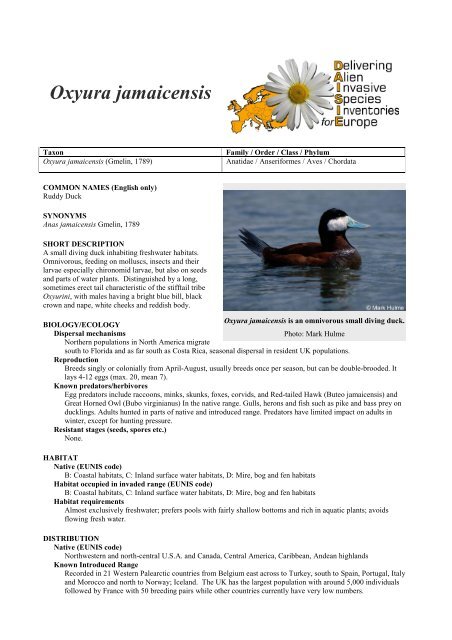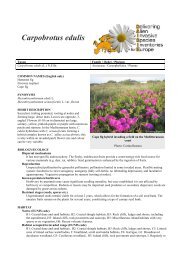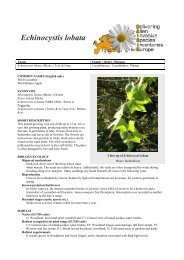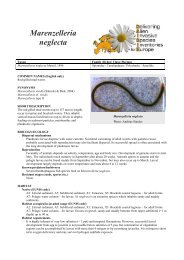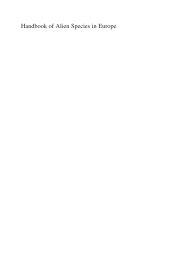Oxyura jamaicensis
Oxyura jamaicensis
Oxyura jamaicensis
You also want an ePaper? Increase the reach of your titles
YUMPU automatically turns print PDFs into web optimized ePapers that Google loves.
<strong>Oxyura</strong> <strong>jamaicensis</strong><br />
Taxon Family / Order / Class / Phylum<br />
<strong>Oxyura</strong> <strong>jamaicensis</strong> (Gmelin, 1789) Anatidae / Anseriformes / Aves / Chordata<br />
COMMON NAMES (English only)<br />
Ruddy Duck<br />
SYNONYMS<br />
Anas <strong>jamaicensis</strong> Gmelin, 1789<br />
SHORT DESCRIPTION<br />
A small diving duck inhabiting freshwater habitats.<br />
Omnivorous, feeding on molluscs, insects and their<br />
larvae especially chironomid larvae, but also on seeds<br />
and parts of water plants. Distinguished by a long,<br />
sometimes erect tail characteristic of the stifftail tribe<br />
Oxyurini, with males having a bright blue bill, black<br />
crown and nape, white cheeks and reddish body.<br />
<strong>Oxyura</strong> <strong>jamaicensis</strong> is an omnivorous small diving duck.<br />
BIOLOGY/ECOLOGY<br />
Dispersal mechanisms<br />
Photo: Mark Hulme<br />
Northern populations in North America migrate<br />
south to Florida and as far south as Costa Rica, seasonal dispersal in resident UK populations.<br />
Reproduction<br />
Breeds singly or colonially from April-August, usually breeds once per season, but can be double-brooded. It<br />
lays 4-12 eggs (max. 20, mean 7).<br />
Known predators/herbivores<br />
Egg predators include raccoons, minks, skunks, foxes, corvids, and Red-tailed Hawk (Buteo <strong>jamaicensis</strong>) and<br />
Great Horned Owl (Bubo virginianus) In the native range. Gulls, herons and fish such as pike and bass prey on<br />
ducklings. Adults hunted in parts of native and introduced range. Predators have limited impact on adults in<br />
winter, except for hunting pressure.<br />
Resistant stages (seeds, spores etc.)<br />
None.<br />
HABITAT<br />
Native (EUNIS code)<br />
B: Coastal habitats, C: Inland surface water habitats, D: Mire, bog and fen habitats<br />
Habitat occupied in invaded range (EUNIS code)<br />
B: Coastal habitats, C: Inland surface water habitats, D: Mire, bog and fen habitats<br />
Habitat requirements<br />
Almost exclusively freshwater; prefers pools with fairly shallow bottoms and rich in aquatic plants; avoids<br />
flowing fresh water.<br />
DISTRIBUTION<br />
Native (EUNIS code)<br />
Northwestern and north-central U.S.A. and Canada, Central America, Caribbean, Andean highlands<br />
Known Introduced Range<br />
Recorded in 21 Western Palearctic countries from Belgium east across to Turkey, south to Spain, Portugal, Italy<br />
and Morocco and north to Norway; Iceland. The UK has the largest population with around 5,000 individuals<br />
followed by France with 50 breeding pairs while other countries currently have very low numbers.
Trend<br />
Increasing in several European countries; some actions to control populations exist in at least 15 Western<br />
Palearctic countries.<br />
MAP (European distribution)<br />
Known in country<br />
Legend<br />
Known in CGRS square<br />
INTRODUCTION PATHWAY<br />
Escapes and accidental releases from waterfowl collections and breeding farms<br />
Natural spread to Europe from UK populations.<br />
Known in sea<br />
IMPACT<br />
Ecosystem Impact<br />
Hybridization with two species including the VULNERABLE White-headed Duck, <strong>Oxyura</strong> leucocephala. It is<br />
dominant over this species in the wild. First and second generation hybrid back-crosses with the Ruddy Duck<br />
are fertile and dominant also. A serious threat to this species.<br />
Health and Social Impact<br />
None.<br />
Economic Impact<br />
Costs of eradication are considerable. There is an ongoing eradication program in the UK since 1992 with the<br />
goal of reducing the population to less than 175 birds or 5 % of the 1999 population at an estimated cost of 3.6<br />
million GB Pounds or 4.4 million Euros over a 4-6 year period. By 2004, at least 15 countries in the Western<br />
Palearctic were taking actions to control populations. Approximately 5,500 individuals have been controlled in<br />
various countries, particularly the UK (5,100), France (246) and Spain (217).<br />
MANAGEMENT<br />
Prevention<br />
Major steps are to establish baseline information and monitor existing wild and captive populations. Legislation<br />
should be improved to prevent deliberate introductions and to limit or remove populations. Strict controls, such<br />
as licensing, should be put in place to prevent escapes or ban their inclusion in captive collections.<br />
Mechanical<br />
Culling (shooting) has been applied in France since 1998, Spain since 1993 and Portugal. The largest population<br />
and assumed source of some introductions is the UK where culling has been controversial.
Chemical<br />
None.<br />
Biological<br />
None.<br />
REFERENCES<br />
Hughes B (2005) Ruddy Duck <strong>Oxyura</strong> <strong>jamaicensis</strong>. In: Kear J (ed) Bird families of the world: ducks, geese and<br />
swans, Oxford University Press, Oxford<br />
Hughes B, Robinson J, Green AJ, Li ZWD, Mundkur T (2006) International single species action plan for the<br />
conservation of the White-headed Duck <strong>Oxyura</strong> leucocephala. Retrieved from http://www.unepaewa.org/publications/technical_series/ts8_ssap_white-headed-duck_complete.pdf<br />
on October 24, 2006<br />
Owen M, Callaghan D, Kirby J (2006). Guidelines on Avoidance of Introductions of Non-native Waterbird Species.<br />
AEWA Technical Series No. 12. Bonn, Germany. http://www.unep-aewa.org/publications/technical_series.htm<br />
OTHER REFERENCES<br />
Blair MJ, McKay H, Musgrove AJ, Rehfisch MM (2000) Review of the Status of Introduced Non-Native Waterbird<br />
Species in the Agreement Area of the African-Eurasian Waterbird Agreement Research Contract CR0219.<br />
British Trust for Ornithology. Thetford, Norfolk, 129<br />
Brua RB (1999) Ruddy Duck nesting success: Do nest characteristics deter nest predation? Condor 101:867-870<br />
Cramp S, Simmons KEL (1977) Handbook of the Birds of Europe, the Middle East and North Africa. Oxford<br />
University Press. Oxford<br />
Green AJ, Hughes BJ (2001) <strong>Oxyura</strong> leucocephala White-headed Duck. In: Parkin DB. BWP Update: The journal<br />
of birds of the Western Paleoarctic. 79-90, Oxford University Press, Oxford.<br />
Hagemeijer EJM, Blair MJ (Eds) (1997) The EBCC Atlas of European Breeding Birds: Their Distribution and<br />
Abundance. T & AD Poyser, London<br />
Hill M, Baker R, Broad G, Chandler PJ, Copp GH, Ellis J, Jones D, Hoyland C, Laing I, Longshaw Moore N,<br />
Parrott D, Pearman D, Preston C, Smith RM, Waters R (2005) Audit of non-native species in England. English<br />
Nature Research Reports. Retrieved from http://www.english-nature.org.uk/pubs/publication/PDF/662.pdf on 7<br />
November 2005<br />
Munoz-Fuentes V, Green AJ, Sorenson MD, Negro JJ, Vila C (2006) The ruddy duck <strong>Oxyura</strong> <strong>jamaicensis</strong> in<br />
Europe: natural colonization or human introduction? Molecular Ecology 15 (6):1441-1453<br />
Hughes B (2006) Issg: Ecology of <strong>Oxyura</strong> <strong>jamaicensis</strong>. Retrieved from<br />
http://www.issg.org/database/species/ecology.asp?si=152&fr=1&sts=sss on October 15, 2006.<br />
Hughes B, Criado J, Delany S, Gallo-Urse U, Green AJ, Grussu M, Perrenou C, Torres JA (1999) The status of the<br />
North American ruddy duck <strong>Oxyura</strong> <strong>jamaicensis</strong> in the Western Palearctic: towards an action plan for<br />
eradication. Wildlife and Wetlands Trust to the Council of Europe.<br />
Kear J (1964) Wildfowl and Agriculture in Britain. Proc. M.A.R. Conf., pp. 321-331, I.U.C.N. Publ. New Ser. (3)<br />
Lever C (1987) Naturalized Birds of the World. Longman. London<br />
Long JL (1981) Introduced Birds of the World. Universe Books. New York<br />
Author: Susan Shirley<br />
Date Last Modified: February 21st, 2007


